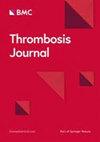抗凝剂治疗和预防肾功能不全 VTE 患者的有效性和安全性:系统回顾和荟萃分析
IF 2.6
4区 医学
Q2 HEMATOLOGY
引用次数: 0
摘要
静脉血栓栓塞症(VTE)合并肾功能不全(RI)的患者出血和血栓形成的风险较高。指南中关于这些患者抗凝治疗的建议仍不明确。本研究旨在比较不同抗凝治疗方案对合并 RI 的 VTE 患者在不同治疗和预防阶段的疗效和安全性。我们对 Pubmed、EMBASE 和 Web of Science 进行了英文检索(起始时间至 2022 年 11 月)。我们选择了评估抗凝药物在 RI 患者急性期、延长期和预防期治疗 VTE 的研究,并报告了疗效和安全性结果。在结果层面上,采用 Cochrane 偏倚方法小组开发的偏倚风险评估工具对研究的方法学质量进行了评估。我们对 25 项 RCT 进行了荟萃分析,其中包括 23 篇文章的数据,共涉及 9,680 名 RI 患者。在急性期,新型口服抗凝药(NOACs)的出血风险比 LMWH 高(RR 1.29,95% CI 1.04-1.60)。在预防 VTE 方面,与安慰剂相比,NOAC 的出血风险升高(RR 1.31,95%CI 1.02-1.68)。与非 RI 患者相比,在急性期,NOACs 和维生素 K 拮抗剂(VKA)都会增加 RI 患者的出血风险(RR 分别为 1.45,95%CI 1.14-1.84 和 RR 1.53,95%CI 1.25-1.88),而 NOACs 可能会增加 RI 患者的 VTE 发生率(RR 1.74,95%CI 1.29-2.34)。接受常规抗凝治疗的 RI 患者发生不良后果的风险明显更高。LMWH 是治疗或预防 RI 患者 VTE 的最有效、最安全的选择。- 与接受常规抗凝治疗的非肾功能不全(RI)患者相比,肾功能不全(RI)患者发生不良后果(尤其是出血)的风险明显更高。- 对于接受 VTE 治疗和预防的 RI 患者来说,低分子量肝素(LWMH)在疗效和安全性方面都是一个最佳选择。- 这些研究结果为合并 RI 患者治疗和预防 VTE 的最佳抗凝药物选择提供了全面的证据。本文章由计算机程序翻译,如有差异,请以英文原文为准。
Efficacy and safety of anticoagulant for treatment and prophylaxis of VTE patients with renal insufficiency: a systemic review and meta-analysis
Patients with venous thromboembolism (VTE) comorbid renal insufficiency (RI) are at higher risk of bleeding and thrombosis. Recommendations in guidelines on anticoagulation therapy for those patients remain ambiguous. The goal of this study is to compare the efficacy and safety between different anticoagulant regimens in VTE patients comorbid RI at different stages of treatment and prophylaxis. We performed English-language searches of Pubmed, EMBASE, and Web of Science (inception to Nov 2022). RCTs evaluated anticoagulants for VTE treatment at the acute phase, extension phase, and prophylaxis in patients with RI and reported efficacy and safety outcomes were selected. The methodological quality of the studies was assessed at the outcome level using the risk-of-bias assessment tool developed by the Cochrane Bias Methods Group. A meta-analysis of twenty-five RCTs was conducted, comprising data from twenty-three articles, encompassing a total of 9,680 participants with RI. In the acute phase, the risk of bleeding was increased with novel oral anticoagulants (NOACs) compared to LMWH (RR 1.29, 95% CI 1.04–1.60). For the prophylaxis of VTE, NOACs were associated with an elevated risk of bleeding compared with placebo (RR 1.31, 95%CI 1.02–1.68). In comparison to non-RI patients, both NOACs and vitamin K antagonists (VKA) could increase the risk of bleeding among RI patients (RR 1.45, 95%CI 1.14–1.84 and RR 1.53, 95%CI 1.25–1.88, respectively) during acute phase, while NOACs may increase the incidence of VTE in RI population (RR 1.74, 95%CI 1.29–2.34). RI patients who are under routine anticoagulation have a significantly higher risk of adverse outcomes. LMWH is the most effective and safe option for VTE treatment or prophylaxis in patients with RI. • Renal insufficient (RI) patients were at significant higher risk of adverse outcomes, especially bleeding, than non-RI patients under the use of routine anticoagulation treatment. • Low molecular weight heparin (LWMH) would be an optimized option for patients with RI undergoing VTE treatment and prophylaxis, both in terms of efficacy and safety. • These findings provide comprehensive evidence for the optimal choice of anticoagulants for the treatment and prevention of VTE in patients with comorbid RI.
求助全文
通过发布文献求助,成功后即可免费获取论文全文。
去求助
来源期刊

Thrombosis Journal
Medicine-Hematology
CiteScore
3.80
自引率
3.20%
发文量
69
审稿时长
16 weeks
期刊介绍:
Thrombosis Journal is an open-access journal that publishes original articles on aspects of clinical and basic research, new methodology, case reports and reviews in the areas of thrombosis.
Topics of particular interest include the diagnosis of arterial and venous thrombosis, new antithrombotic treatments, new developments in the understanding, diagnosis and treatments of atherosclerotic vessel disease, relations between haemostasis and vascular disease, hypertension, diabetes, immunology and obesity.
 求助内容:
求助内容: 应助结果提醒方式:
应助结果提醒方式:


